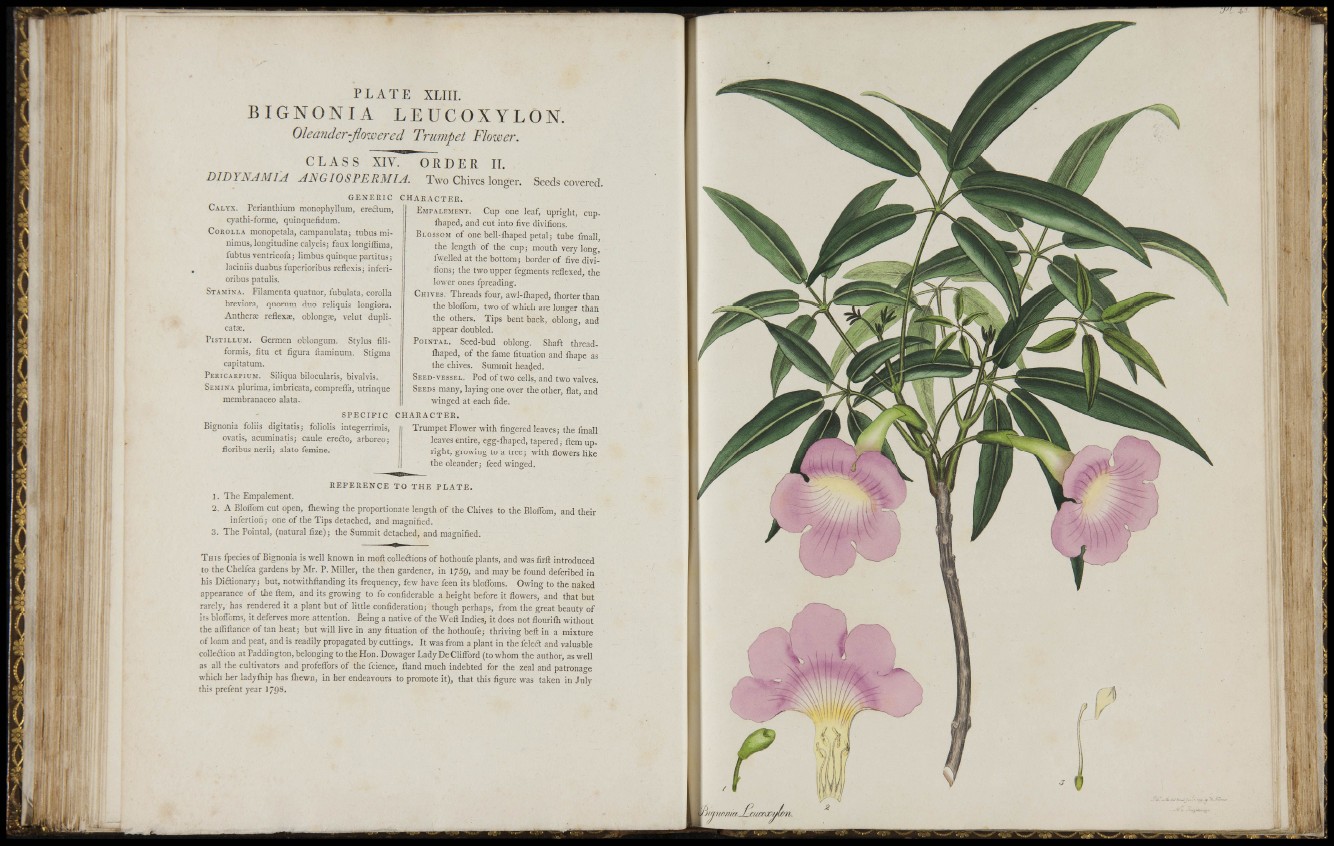
í -i I
s!
S b i
P L A T E XLIII.
B I G N O N I A LEUCOXYLON.
Oieander-flowered Trumpet Flo-iver.
C L A S S XIV.
DIDYNAMIA ANGIOSPERMI'.A .
O R D E R IL
Two Chives longer. Seeds covered
GE^'ERIC
CALYX, reriantliium monophylliim, ereflura,
cyathi-lbrine, quinquefidiim.
COROLLA monopetala, campanulata; tubas minimus,
longitudine calycis; faux longiflima,
lubtus ventricola; limbus quinque partitus;
laciniis duabus iuperioribus reflexis; inferioribus
patulis.
STAMINA. Filamenta quatuor, lubulata, corolla
breviora, quorum duo reliquis longiora.
Antherae reflexEe, oblongae, veliit duplica
tie.
PisTiLLUM. Germen oblongum. Stylus filiformis,
iitu et figura fiaminum. Stigma
capita tum.
PEKICAKPIUM. Siliqua bilocularis, bivalvis.
SEMINA plurima, imbricata, comprefla, utrinque
membranaceo alata.
S P E C I F I C
Bignonia foliis digitalis; foliolis integerrimis,
ovatis, acuminatis; caule ereélo, arboreo;
floribus nerii; alato femine.
CHAEACTEIÎ.
EMPALEMENT. Cup one leaf, upright, cupiliaped,
and cut into five divifions.
BLOSSOM of one bell-iliaped petal ; tube final!,
the length of the cup; mouth very long,
fwelled at the bottom; border of five divifions;
the two upper fegments rcflexed, the
lower ones fpreading.
CHIVES. Threads four, awl-fliaped, iliorter than
the bloflbm, two of which are longer than
the others. Tips bent back, oblong, and
appear doubled.
POINTAL. Seed-bud oblong. Shaft threadiliaped,
of the fame fituation and fliape as
the chives. Summit headed.
SEED-VESSEL. Pod of two cells, and two valves.
SEEDS many, laying one over the other, flat, and
winged at each fide.
CHARACTER.
Trumpet Flower with fingered leaves; the fmall
leaves entire, egg-iliaped, tapered, ftem upright,
growing to a tree; with flowers like
the oleander; feed winged.
REFERENCE TO THE PLATE.
1. The Empalement.
2. A Bloflbm cut open, fliewing the proportionate length of the Chives to the Bloflbm, and their
infertioh; one of the Tips detached, and magnified.
3. The Pointal, (natural fize); the Summit detached, and magnified.
THIS fpecies of Bignonia is well known in moft coUeftions of hothoufe plants, and was firft introduced
to the Chelfea gardens by Mr. P. Miller, the then gardener, in 1759, and may be found defcribed in
his Diftionar}-; but, notwithftanding its frequency, few have feen its bloflbms. Owing to the naked
appearance of tlie fl:em, and its growing to fo confiderable a height before it flower.s, and that but
rarely, has rendered it a plant but of little confideration; though perhaps, from the great beauty of
its bloflbms, it deferves more attention. Being a native of the Weft Indies, it does not flourifli without
the afliftance of tan heat; but will live in any fituation of the hothoufe; thriving beft in a mixture
of loam and peat, and is readily propagated by cuttings. It was f rom a plant in the feleit and valuable
colleftion at Paddington, belonging to the Hon. Dowager Lady De Clifford ( towhom the author, as well
as all the cultivators and profeflfors of the fcience, Hand much indebted for the zeal and patronage
which her ladyihip has fliewn, in her endeavours to promote it), that this figure was taken in July
this prefent year 1798.